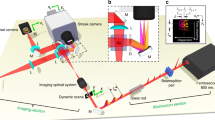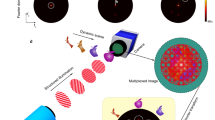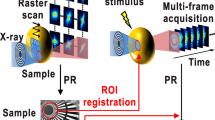Abstract
Recording a ‘molecular movie’ with atomic spatial resolution on the femtosecond timescale set by atomic motion can be considered the ultimate goal of dynamic real-space imaging. Free-electron X-ray lasers, with their (sub)nanometre wavelength, femtosecond pulse duration and high brilliance, fuel the hope that this may ultimately become possible. Single-shot still pictures with sub-100 nm resolution achieved during femtosecond exposures have recently been demonstrated1,2,3. A femtosecond time-lapse movie requires a sequence of independent images taken with a controllable time delay. As a key step towards achieving a molecular movie, we demonstrate a holographic imaging approach capable of recording two fully independent images with a variable time delay over the entire femtosecond regime. The concept overcomes the fundamental readout time limitations of two-dimensional area detectors, as two subsequent X-ray holograms of a sample can be superimposed within one detector exposure and yet be unambiguously disentangled to reconstruct two independent images.
This is a preview of subscription content, access via your institution
Access options
Subscribe to this journal
Receive 12 print issues and online access
$209.00 per year
only $17.42 per issue
Buy this article
- Purchase on Springer Link
- Instant access to full article PDF
Prices may be subject to local taxes which are calculated during checkout



Similar content being viewed by others
References
Chapman, H. N. et al. Femtosecond diffractive imaging with a soft-X-ray free-electron laser. Nature Phys. 2, 839–843 (2006).
Marchesini, S. et al. Massively parallel X-ray holography. Nature Photon. 2, 560–563 (2008).
Barty, A. et al. Ultrafast single-shot diffraction imaging of nanoscale dynamics. Nature Photon. 2, 415–419 (2008).
Dwyer, J. R. et al. Femtosecond electron diffraction: ‘making the molecular movie’. Phil. Trans. R. Soc. A 364, 741–778 (2006).
Miller, R. J. D. et al. Making the molecular movie: first frames. Acta Crystallogr. A 66, 137–156 (2010).
Mitzner, R. et al. Spatio-temporal coherence of free electron laser pulses in the soft X-ray regime. Opt. Express 16, 19909–19919 (2008).
Mitzner, R. et al. Direct autocorrelation of soft-X-ray free-electron-laser pulses by time-resolved two-photon double ionization of He. Phys. Rev. A 80, 025402 (2009).
Ackermann, W. et al. Operation of a free-electron laser from the extreme ultraviolet to the water window. Nature Photon. 1, 336–342 (2007).
Eisebitt, S. et al. Lensless imaging of magnetic nanostructures by X-ray spectro-holography. Nature 432, 885–888 (2004).
Schlotter, W. F. et al. Multiple reference Fourier transform holography with soft X rays. Appl. Phys. Lett. 89, 163112 (2006).
Pfau, B. et al. Femtosecond pulse X-ray imaging with a large field of view. New J. Phys. 12, 095006 (2010).
Chapman, H. N. et al. Femtosecond time-delay X-ray holography. Nature 448, 676–679 (2007).
Saldin, E. L., Schneidmiller, E. A. & Yurkov, M. V. Self-amplified spontaneous emission FEL with energy-chirped electron beam and its application for generation of attosecond X-ray pulses. Phys. Rev. ST Accel. Beams 9, 050702 (2006).
Emma, P. et al. Femtosecond and subfemtosecond X-ray pulses from a self-amplified spontaneous-emission-based free-electron laser. Phys. Rev. Lett. 92, 074801 (2004).
Stadler, L.-M. et al. Hard X ray holographic diffraction imaging. Phys. Rev. Lett. 100, 245503 (2008).
He, H. et al. Inversion of X-ray diffuse scattering to images using prepared objects. Phys. Rev. B 67, 174114 (2003).
Roseker, W. et al. Performance of a picosecond X-ray delay line unit at 8.39 keV. Opt. Lett. 34, 1768–1770 (2009).
Guizar-Sicairos, M. et al. Holographic X-ray image reconstruction through the application of differential and integral operators. Opt. Lett. 35, 928–930 (2010).
Acknowledgements
The authors thank the FLASH machine and experiments team for their great support. The assistance of the Bundesministerium für Bildung und Forschung (grants 05 KS4PMC/8 and 05 KS7PM1) within the priority research area FSP 301–FLASH is acknowledged.
Author information
Authors and Affiliations
Contributions
The experiment was conceived by C.M.G., B.P. and S.E. It was carried out at FLASH by C.M.G., B.P. and S.E. together with R.M., B.S., S.R. and H.Z., who characterized and operated the autocorrelator, and with R.T., who operated the beamline and data acquisition tools. The holography mask was produced by O.K., I.R. and D.S.
Corresponding authors
Ethics declarations
Competing interests
The authors declare no competing financial interests.
Supplementary information
Rights and permissions
About this article
Cite this article
Günther, C., Pfau, B., Mitzner, R. et al. Sequential femtosecond X-ray imaging. Nature Photon 5, 99–102 (2011). https://doi.org/10.1038/nphoton.2010.287
Received:
Accepted:
Published:
Issue Date:
DOI: https://doi.org/10.1038/nphoton.2010.287
This article is cited by
-
Coherent correlation imaging for resolving fluctuating states of matter
Nature (2023)
-
Ultrashort laser pulse doubling by metal-halide perovskite multiple quantum wells
Nature Communications (2020)
-
Monolithic focused reference beam X-ray holography
Nature Communications (2014)



